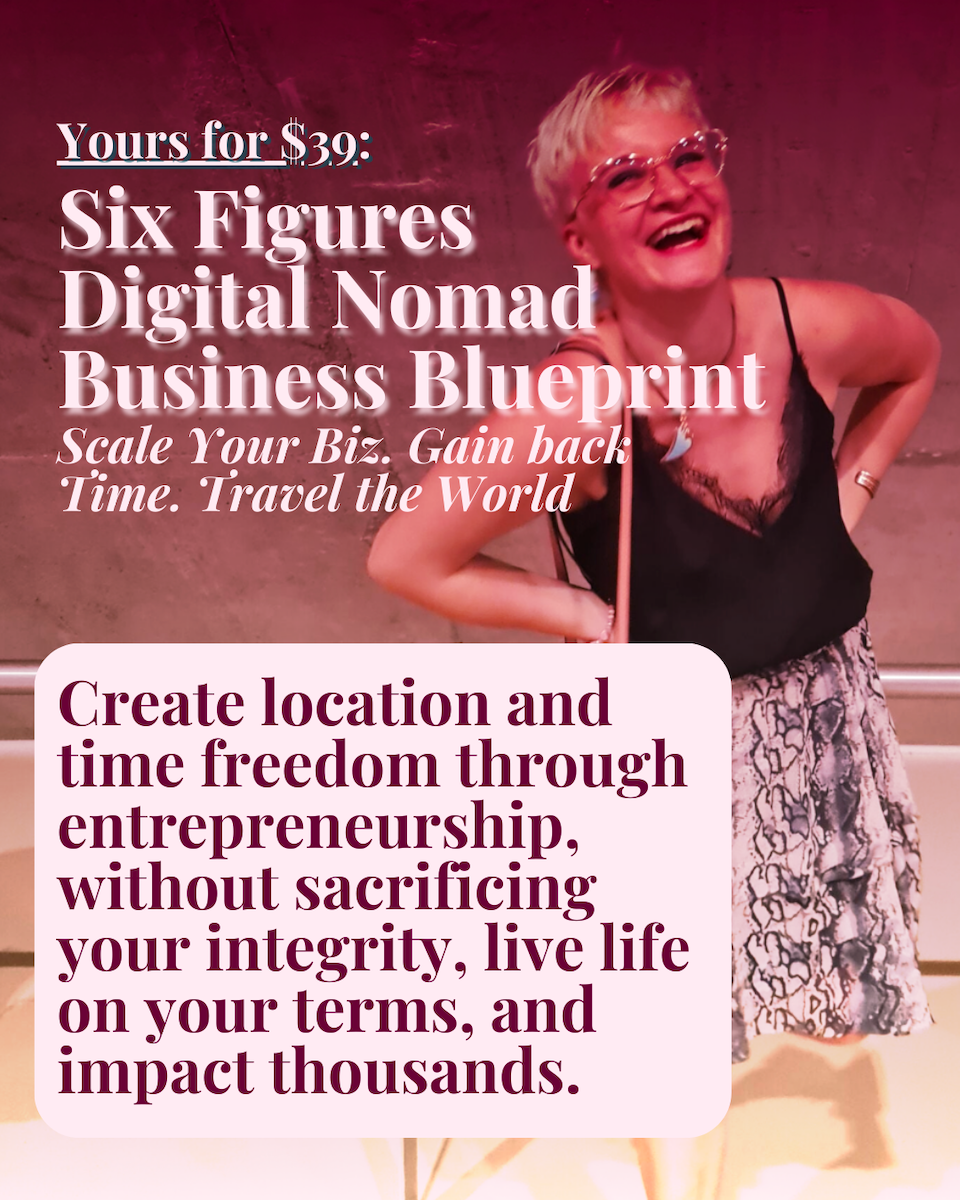Any good relationship is built on healthy boundaries—wouldn’t you agree? This applies not only to friendships and romantic partnerships but also to professional coaching boundaries a coach sets with their clients.
As a coach, maintaining professional coaching boundaries is essential for creating a transformative experience for your clients and for scaling your business forward, particularly if you’re a digital nomad or location-independent entrepreneur.
Without clear coaching boundaries, you risk burnout—whether it’s answering calls at 8 PM or, worse, 3 AM – or making it harder for your clients to break free from the patterns that are holding them back.
And let’s be real, helping your clients reach their fullest potential is what you’re here to do.
So, how do you set coaching boundaries in a healthy, kind, and professional way?
As a location-independent coach who guides other coaches, I’m here to spill the beans on everything you need to have in place to ensure long-term success—for both you and your clients.
Start Now:
It only takes 5 clients to make your dreams come true. Turn existing connections into paying clients without social media and begin to travel the world:

What are Coaching Boundaries?
First, let’s define what coaching boundaries are, as they differ slightly from the boundaries you’d set with a spouse or even a boss.
Why? Because you’re literally getting paid to help change someone’s life, which requires a strong, fortified space where the coaching relationship can thrive.
Coaching boundaries are primarily set and upheld by the coach, for the benefit of the client. The client agrees to respect these boundaries, knowing they support their personal growth and transformation.
It’s essential that coaching boundaries are communicated both in writing—through contracts or agreements—and verbally, especially during an initial conversation.
While clients are responsible for adhering to these boundaries, it’s the coach’s role to reinforce them when necessary. And knowing how to do this in an empowering way is a vital coaching skill and a crucial element of any good coaching package.
Save this article for future reference:
Why do professional boundaries with your coaching clients matter?
Maintaining professional boundaries with your clients is crucial for two reasons:
- For the success of your business and your well-being.
- For the growth and development of your clients.
For your business, setting coaching boundaries ensures smooth operations and clearly defined expectations.
It helps outline what is and isn’t included in your offers, preventing overwork and burnout. For example, defining when and how you’ll respond to client messages helps manage operations efficiently.
Likewise, saying something like, “This topic isn’t covered in this particular program, but you’re welcome to join this program for more in-depth support,” helps you stick to your scope of work while avoiding over-delivering, which can otherwise cannibalize your other offers (yes, you should have more than one offer, here’s why.)
For your clients, clear professional boundaries are essential to their growth. Without boundaries, some clients may subconsciously slip into co-dependent behaviors, stunting their progress.
Additionally, unclear boundaries can leave clients unsure of how or where to seek support, robbing them of an integral part of the coaching process.
In coaching, boundaries aren’t restrictions—they’re empowering guidelines designed to foster holistic growth.
Free Webinar:
Get Started with your Digital Nomad Coaching Business:
Build a Thriving Location-Independent Coaching Business
Taught by a Veteran Digital Nomad, 6-Figure Professional Coach, and fierce Freedom Seeker, Dina-Marie.
Learn how to create a scalable, freedom-based business that lets you live and work from anywhere. Sign up below to get access:
How to set Coaching Boundaries before you Start Coaching
There are two distinct moments in the customer journey where it’s crucial to set coaching boundaries.
The first occurs before any coaching agreement is made, and no money has exchanged hands yet. The second happens holistically throughout the coaching container itself.
Beyond these moments, many coaching boundaries aren’t enforced by words or actions—they’re communicated through how you, as the coach, show up for your clients.
Remember, boundaries work best when you lead by example.
Read also: How to manage your money as a location independent entrepreneur
Before you get on your first call
Most coaching boundaries are set before your first call with a potential client. Your client must know exactly what they’re signing up for. This includes:
- The length of the call and the expectation for them to be in a quiet, private space.
- What they should have prepared, if anything.
- What will happen during the call.
- Your cancellation policy.
You can automate this process using tools like Calendly or Google Scheduler, or send the information via email. You can even view my coaching policies and the language I use here.
For private clients, I also send prep work before our first call to set the tone and differentiate it from an ordinary conversation.
I’d encourage you to be willing to cancel the call without make-up if they’re more than five minutes late. Further, feel free to re-schedule or even cancel the call if your coachee calls in from a noisey space.
Read also: Setting the right boundaries is mostly a mindset, this article about How to Thrive on the Road with a Freedom Business can support you.
Understanding Scope of Work
When discussing private coaching, it’s crucial to clearly define what is and isn’t included in your scope of work.
Be firm but kind—don’t feel obligated to throw in extras simply because they ask.
As for evergreen courses, clearly outline what’s included. If you’re running live programs, only answer questions related to the program’s current goals.
By setting these expectations upfront, you’ll prevent disappointment or tension during the coaching process.
Notice the nuance here: I review plenty of websites, emails, and Instagram profiles, but I don’t offer tech support. That’s outside the scope of my coaching container.
Not sure how to create offers, or why I even talk about 1:1, evergreen, and live programs in one and the same breath? I’ve gotchu here.
Read also: How to Become a Digital Nomad with No Experience? (?!)
Create Clear Communication Guidelines
Before taking on any paid clients, it’s your responsibility to establish clear guidelines about where, how, and when communication happens.
For example, if a potential client reaches out via your personal email or WhatsApp, your response should be, “Let’s move this conversation to X, where I handle all work-related matters.”
If someone seeks free coaching advice in your DMs, kindly redirect them to relevant resources, like a blog post or free guide.
For paying clients, define how and when they can communicate with you outside of scheduled calls. Remember, 24/7 access is not necessary for coaching clients.
Set up a Contract
Once a client agrees to work with you, the first step is paperwork. No coaching should occur before a signed contract and payment are received.
Your contract should clearly outline the length of the engagement, scope of work, and payment plan. Be sure to include a disclaimer that distinguishes coaching from therapy, as well as a no-refund policy.
Make sure to communicate clearly in your sales call or email when the signed contract and payment are due.
Choose the right clients
This is more than just about boundaries—it’s about energy and alignment. While this may be less relevant for evergreen courses, it’s crucial when onboarding clients into close-proximity containers.
Choosing the right clients is essential for respecting coaching boundaries. That’s why I recommend getting on a call with potential clients before they commit to your close-proximity programs.
My main question for my clients is this: Does this person inspire you? Not, do they have money to pay you.
This is irrelevant. If the wrong client enters your space, you’ll quickly feel drained, and it will show across your entire business.
The Blueprint for Rebels:
6 Figure Digital Nomad Entrepreneur Blueprint
Create location and time freedom through service-based entrepreneurship, without sacrificing your integrity, time, or sass, live life on your terms, and impact thousands.
This blueprint outlines exactly what to focus on, and what to throw by the wayside, in order to grow a business that travels, scales, and serves, all while giving you back time and celebrating who you are.
How to Maintain Professional Boundaries with your Current Clients:
Now, let’s dive into the truly transformative aspect of maintaining coaching boundaries. Inside an existing coaching container, every interaction is an opportunity to slow down and create powerful insights.
I’ve seen this firsthand.
For example, one of my clients had a major breakthrough with her finances after defaulting on a payment. We dedicated an entire session to explore her relationship with money, and the insight she gained from that process transformed her entire financial approach. And she was never again late on a payment.
Another client missed the first eight minutes of a call and found a supportive, yet firm message from me in Slack (I had already left the zoom call at the point). That moment pushed her to tighten her own client boundaries, and within two weeks, she signed her first $10k client.
Boundaries create growth.
Let’s walk through common scenarios where you can use boundaries to create these coaching moments.
Read also: How working with a digital nomad coach can change your life.
Save this article for later:
Coaching Boundaries with your Time
When it comes to time management, you’ll want to be clear about these coaching boundaries:
- When you take calls
- Your rescheduling policy
- Your punctuality policy
First, set specific time slots for calls. If you don’t, your clients will feel like scheduling is flexible. But let me tell you, without clear boundaries, time inefficiencies will creep into your business. Requests for calls outside of your predetermined times should only be honored in special circumstances.
Next, you need a solid rescheduling policy. For example, my clients can reschedule one call during a six-month contract and two during a 12-month contract. Emergencies are exceptions, of course. This isn’t to restrict them, but to offer them an opportunity to prioritize their own growth.
Lastly, I’m firm about punctuality. I once had a client show up 20 minutes late for a VIP day, and we didn’t reschedule or refund. That’s a boundary meant to respect both my time and theirs.
Coaching Boundaries with your Clients
Boundaries with clients must cover:
- What you coach on
- When you coach
- Follow-through on the coaching process
It’s vital to set clear boundaries about what you do and don’t coach on. For business coaches, this might seem straightforward, but for life coaches or those with broader practices, it’s essential to clarify the difference between coaching and therapy.
Also, draw a line between being a coach and a service provider. For instance, an early client once asked me to put together a list of potential collaborators for her career. I declined but realized I hadn’t properly defined my role. She didn’t renew, and that taught me an important lesson about clarity (as well as the limiting beliefs I had around money).
Furthermore, your clients need to know when they’ll hear from you, and you need to stick to that, if not for your mental health, for the fact that you must lead by example. There’s no such thing as a coaching emergency, so don’t coach on the weekends.
Finally, push your clients to follow through. If they aren’t taking action, slow down and help them establish systems to break the cycle. As a coach, your job is to help them maximize their potential.
Coaching Boundaries with your Money and Contracts
When it comes to money, you need boundaries around:
- Late payments
- Refund requests
- Ghosting clients
Late Payments
This one is simple but not without compassion. If a client defaults on a payment, no coaching happens until it’s resolved. But how you communicate this can make or break the relationship.
I usually hop on a quick call to ask, “What’s going on?” The key is to maintain a firm energy while speaking with compassion.
Most clients feel shame or fear when they default. These emotions likely influence their money decisions elsewhere, too. Slow down, and help them create a plan that moves them out of fear and into action.
Refund Requests
Refund requests are a “no” from me. My clients agree to my terms upfront, and I have a no-refund policy.
But again, I don’t simply decline. I’ll check in and approach the conversation with empathy while holding firm in my policies.
Boundaries don’t have to be rigid; they can be compassionate and clear at the same time. And when you approach your policies from that place, even boundaries can create life-changing insights for your clients.
Ghosting Clients
If a client ghosts you, you have to decide whether chasing the payment is worth your energy.
With a solid contract and finance system in place, you can send it to collections, but that takes time.
Sometimes it’s better to let go and focus on bringing in more aligned clients. You get to decide what’s best for your energy and your business.
Final Words
Mastering the art of setting and maintaining boundaries is crucial for delivering a truly transformative experience to your clients while ensuring the health of your coaching business—and your own well-being.
Remember, boundaries aren’t roadblocks. When communicated effectively and with compassion, they’re the guardrails guiding your clients toward growth and change.
If this article was helpful, share and save it:








0 Comments